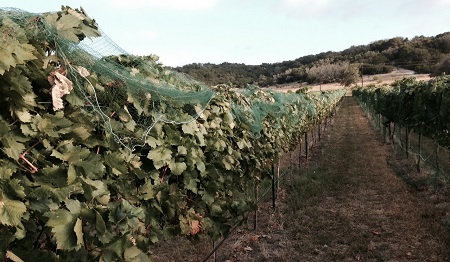Kuhlman Cellars Blog
Roll Out the Barrel!
What is the first thing that comes to mind when you think of a dusty old cellar beneath a Chateau in France? What is the first thing people want to see when they tour a winery? The answer for most of us would be the wine barrel. Simply put, the oak barrel is one of the single most romantic things to observe in the cellar, they are equally as beloved in regards to winemaking. Barrels act as a vessel, a membrane between the wine and the oxygen-rich air outside of the barrel. These metal-hooped, toasted bunches of oak slats, call staves, are oh-so important to the art of making fine wine. Let us take a look into the world of wine barrels, and why they are an integral tool in the cellar.
Firstly, why barrel age a wine? A wine barrel acts as a porous barrier, allowing small amounts of oxygen transfer to occur over time. This aspect of barrel aging really helps to achieve structure and marriage of flavors in a wine. Second, it is very common to obtain flavors from a new oak barrel during its first use, typically within the first year or two of a barrel’s life. After such time, the barrel becomes what we call neutral, basically meaning it imparts little flavor into the wine, but the oxidative effect and additional tannins from the wood are still very much present.
There are several regions in which we harvest oak, but the two most common would be French and American oak. Each has their own unique personality and offers different characteristics to the wine housed within them.
 American oak- Harvested from oak in the warmer climate of the United States, this type of wood has looser graining which produces more aggressive flavor profiles. Baking spices, dill, vanilla and toasty flavors are often exuded from American oak.
American oak- Harvested from oak in the warmer climate of the United States, this type of wood has looser graining which produces more aggressive flavor profiles. Baking spices, dill, vanilla and toasty flavors are often exuded from American oak.
French oak- Harvested from the cooler climate of France, this type of wood offers tighter graining which produces more gentle flavor profiles. Gentle notes of vanilla and toast can be expected from French oak.
What about tannins? In wine, tannins come from the skins, seeds (called pips), and the stems of the grape clusters. Did you know tannins also are imparted from the oak barrels? Typically we perceive phenolic tannins from the fruit on the front palate, while the tannin compounds from the oak barrels are often sensed on the back palate. Tannins in general are perceived as astringency all over the mouth, and add a ton to the structural mouth-feel of a wine.
Next time you are in a tasting room and are admiring the oak barrels, try and remember how much they add to the finished product in your glass. Let us also give a shout-out to the people that put in the time and effort that went into making a wine barrel by hand.
Vina Vita, my friends!
Carignan
Carignan is a red wine grape known for producing well structured, dry red wines, yet little seems to be written 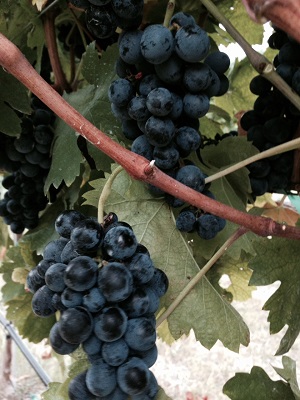 regarding this “under the radar grape”. The truth is, it has significant prominence in both the old world and new world and it is more commonly blended in everyday red wines than one might think, despite not gaining much press. Pronounced “care-in-yawn”, it is a powerful and opulent grape known for deep and concentrated color, bold tannins and high retained acidity. This is no wimpy fruit; it is structurally sound and offers tremendous presence, especially when utilized as a primary blending grape.
regarding this “under the radar grape”. The truth is, it has significant prominence in both the old world and new world and it is more commonly blended in everyday red wines than one might think, despite not gaining much press. Pronounced “care-in-yawn”, it is a powerful and opulent grape known for deep and concentrated color, bold tannins and high retained acidity. This is no wimpy fruit; it is structurally sound and offers tremendous presence, especially when utilized as a primary blending grape.
For those of you not familiar with this grape, just imagine if the well know Merlot and Syrah grapes were to mate, the best qualities of each of those varieties are similar to what Carignan showcases. The variety is presumed to be from Spain originally and is still prevalent in Catalonia, Spain. It is also well known in southern France, from the Languedoc-Roussillon region in particular. California has been growing and blending Carignan for decades and there are mature Carignan vines producing fruit in the Texas High Plains. This grape variety needs to be cultivated in relatively warm and dry climates, as it can be prone to powdery and downy mildew and requires a warm growing season to achieve proper ripeness. The vines tend to be vigorous and must be well managed to produce quality, concentrated fruit. Having said that, Texas seems like a pretty great place to grow Carignan.
At Kuhlman Cellars, we originally planted Carignan in our family experimental block in 2012. We believe this is the first planting in the Fredericksburg AVA. We also believe in its potential as a possible backbone grape for our blending family. It provides a well-balanced yet massive backbone if crop yields and vine canopy are well managed. For those of you who have tasted the 2012 Barranca, you know exactly what I mean. Wines with finesse, power and character come from these interesting blends. We also planted Carignan in our estate vineyard in the Texas Hill Country in 2015. Our largest block, Block 5, with approximately 2.3 acres of Carignan, will be producing fruit in the coming years on the Kuhlman Cellars Estate property. Our usually dry/hot summers, as well as our clay topped limestone soils in central Texas provide a suitable environment for harvests of intense, ripe fruit from our vineyards, so the future of Carignan in our wine program is exciting!
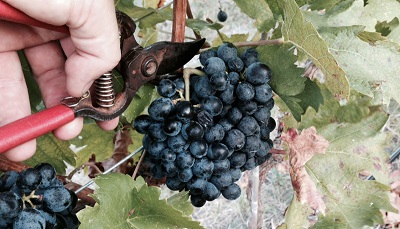
Below is a list of known Texas vineyards currently growing Carignan:
Bingham Family Vineyards- Texas High Plains
Brushy Creek Vineyards- Alvord, Texas
Buena Suerte Vineyards- Texas High Plains
Kuhlman Cellars- Texas Hill Country
La Pradera Vineyard- Texas High Plains
Martin Vineyard- Texas High Plains (believed to be the oldest Texas vines still in production)
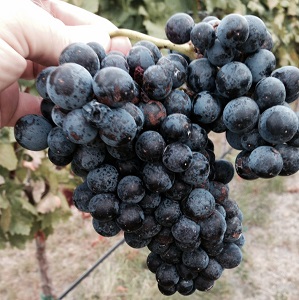
Let’s celebrate the wine life, Vina Vita, and savor everything that is… Carignan.
Cheers!
Texas Terroir, a brief synopsis
There are so many factors involved in producing a quality bottle of wine, as things all begin in the vineyard and make their way to the cellar. Most of us can certainly agree, weather and soil play a very important role in winemaking. What better place to discuss soil types than in the Lone Star State. Texas itself sits on a rock shelf and depending on where you live in our wonderfully enormous state, you either have a little or a whole lot of rocks in your backyard. There is a reason most central Texans construct raised gardens, it is because you can literally bend a pick axe trying to dig into the limestone and caliche. Who wants to rent a Bobcat just to plant tomatoes?
Let’s talk a little about the two largest AVA’s in Texas, and how different the soils can really be. Understand this story is not a definitive- end all lecture about the structure of Texas dirt, merely a brief explanation of some of the key differences between the soil of Central Texas, vs that of the Texas High Plains. With such a large wine style dynamic between fruit from the Hill Country vs the High Plains, there has to be something unique regarding each region right? The answer is yes, both in climate and dirt, this thing we call terroir. What is terroir exactly? Simply put, it is the all-encompassing word for wind, rain, temperature, soil, elevation, etc, of a given region. Here are some interesting facts on the two prominent regions we are discussing.
Texas Hill Country AVA:
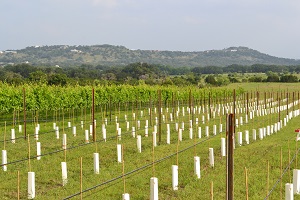
Impressively the second largest AVA in the United States, it covers 9,000,000 acres (14,063 square miles) and contains 2 sub regions; Bell Mountain AVA and Fredericksburg AVA. Elevation can range from roughly 1,000 ft MSL to over 2,500 ft MSL. The weather in central Texas is typically hot during the growing season. Hill Country daily high temperatures average in the in the mid 90’s, while the nights drop into the low 70’s. The soils vary in this region, but limestone and caliche reign. For example, the Kuhlman Cellars Estate Vineyard sits on a bedrock of Caliche with a clay topsoil. There are spots in the vineyard where the clay is only a few inches deep, you can ask our vineyard team. I cannot tell you how many vines we placed directly on white chalky rock when we planted the estate vineyard in April, 2015. It is basically “set the roots on rock, replace the soil, and wish it good luck”. Struggle little fella, struggle! The rocky terroir of central Texas is typically well draining, though the clay can cause all sorts of issues since it retains moisture. The caliche provides good mineral component to the wines made from these vineyards.
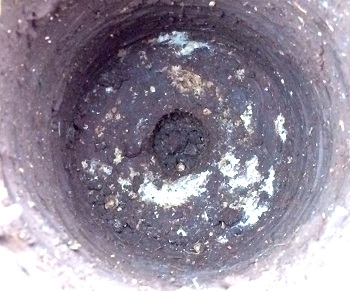
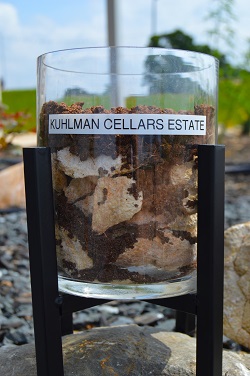
Texas High Plains AVA:
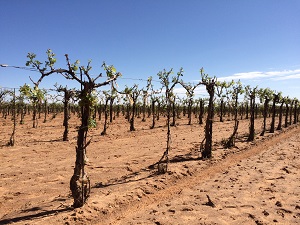
This is the second largest AVA in Texas and it also contains the most vines. It’s estimated, west Texas grows 90% of the fruit grown in the state, especially in the Brownfield/ Lubbock area. The Texas High Plains is far different from the Hill Country in a few ways, the elevation is significantly higher allowing for more of that much needed diurnal shift. Elevation in this region ranges from around 2,500 ft MSL to over 3,700 ft MSL. The soil is mainly composed of red dirt/sand with loam as well. There is quite a bit of rock in Lubbock, but it is typically buried under several feet of the famous red dirt. Sand is very well draining soil. Humidity levels here are typically very low, making the region ideal for grape growing, by reducing the incidence of fungus and molds.
In terms of temperature, the high plains tends to be slightly cooler during the days and the nights cool off into the mid to upper 60’s, providing a larger diurnal shift which helps the grapes rest and recover overnight.
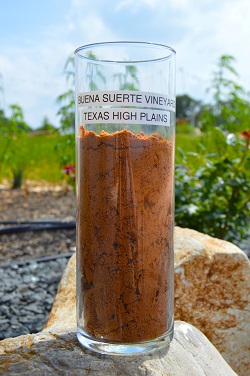
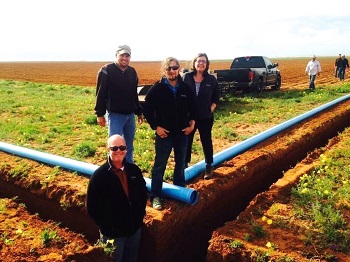
All in all Texas is a diverse place to grow grapes and to make fine wines. I hope this brief synopsis helps you to understand a bit more about our local industry and what makes our two biggest AVA’s so unique, fun and interesting.
Green Efforts
Being "green" is not just a trendy-hip thing these days. Offering mother earth a friendly helping hand is becoming a necessity as the world population steadily increases, as does our waste production both in trash, and waste water. Here at Kuhlman Cellars, being green is very much part of our daily business. Everything from the plates we serve our Chef prepared food on, to the machine we use to sanitize our tanks, they are very earth friendly. Below is a list of things we do to maintain our steady track in keeping our planet happy.
Compost bin:
As you walk from the parking lot to the tasting room, you might notice the large compartmented wooden box sitting to your left near our garden, this is the compost bin. Grass clippings, leaves, paper products, leafy greens, crackers, and fruits all go into the bin and are 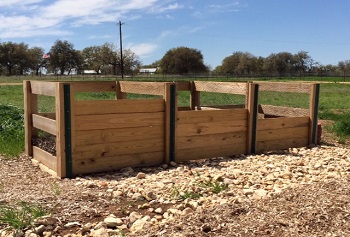
Rain capture and grey water system:
The rain gutters on the roof of the winery, as well as the drains in the cellar floor, divert water through an underground piping system to the pond located at the northeast corner of the property. This is a very low tech and efficient means of moving water. Here is a fun fact... One inch of rain captured via our rain gutter system, translates to approximately 10,000 gallons of water collected. Whoa!
The pond:
Our pond, once full, will be a peaceful retreat, an oasis if you will for guests to admire, and it will eventually offer irrigation capabilities for our vineyard, landscaping and garden.
Glass and cardboard recycling:
We simply could not call ourselves earth friendly if we did not practice good old fashioned recycling. All of the empty wine bottles, wine boxes, and basically all glass and cardboard products are recycled using two recycling centers located in both Johnson City, and Fredericksburg, TX.
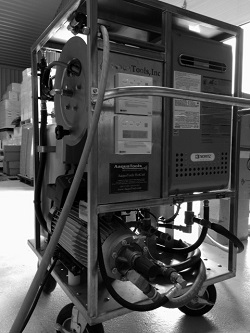
This machine is actually one of my favorite gadgets we have at the winery. Instead of using chemicals and excessive water to clean our tanks and cellar floor, we use a hot cart. This device utilizes water heated to 185 degrees and a high pressure stream to
clean and sanitize. This is not only better for the environment, but also for us humans as well.
Wine shipping boxes:
The boxes we use for shipping our wines are made in California using solar energy.
Basically, the boxes are produced using a green method, and they can also be recycled after the wine consumer receives their wine. How is that for helping out the environment?
It is a great responsibility to be gentle with our loving mother earth, all it takes are a few extra steps in the daily routine to help keep waste to a minimum. Please feel free to ask us anytime about our green habits at Kuhlman Cellars, we are always more than happy to share our practices with each and every one of you.
Cheers to Vina Vita, the wine life.
Field trip to Kuhlman Creek!
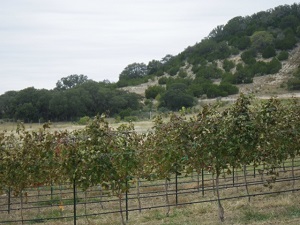
On a bitter cold winter day, some of the Kuhlman Cellars team, including myself, were walking the vines at the Cobb Family Vineyard.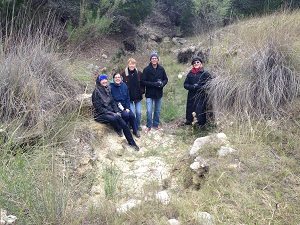 It was a company field trip of sorts and I was excited to finally step foot on the soils of the family "farm". This is where the winery name was born, for Kuhlman Creek which runs through the property and feeds into the Pedernales River when heavy rains fall. During our trip the sky was grey, and the vines had just begun their long winters slumber. Green leaves with hints of red and gold were clinging from the hard worked vines.
It was a company field trip of sorts and I was excited to finally step foot on the soils of the family "farm". This is where the winery name was born, for Kuhlman Creek which runs through the property and feeds into the Pedernales River when heavy rains fall. During our trip the sky was grey, and the vines had just begun their long winters slumber. Green leaves with hints of red and gold were clinging from the hard worked vines.
The 1 acre test block has been a solid experiment over the last few years of how several grape varieties grow on the family property, just north of Fredericksburg, Texas. The vineyard presently contains 9 different grape varieties. This specific piece of land is blessed with terroir conducive to protecting the vines from hail and late spring freezes. Hills to the north have proven to disrupt the worst of severe Thunderstorms, and downward sloping terrain to the south allows cold air during the late spring to flow through and away from the vineyard. This is especially important in protecting our lovely Viognier from having her gentle buds frozen in late March and early April. The intimate tour of the property that day was given by Diane Cobb, our vineyard matron. I hesitate to call her a vineyard manager, because the love she shows each and every vine, is much more motherly than managerial.
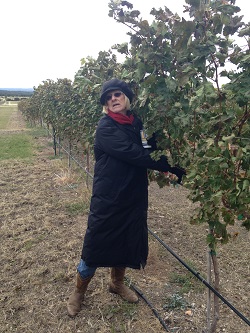
The Vitis Vinifera grape varieties currently planted at the Cobb Family Vineyard:
Aglianico
Alicante Bouschet
Carignan
Mourvèdre
Syrah
Tannat
Tempranillo
Vermentino
Viognier
There is a special estate field blend from the first harvest currently in barrels here at the winery structured solely from the fruit sourced from the Cobb Family Vineyard. This limited release wine will be something to look forward to in a few years once released. This wine will express the unique nuances of the terroir, which is instrumental when it comes to the complexity and individuality of wine.
We invite all of you to come experience the splendors of terroir with each of our carefully made wines at Kuhlman Cellars. Each one tells its own story of the dirt, rainfall, sunlight and wind of that particular growing season.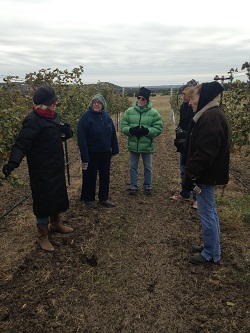
Cheers!
